How to Fertilize Sweet Corn for Optimal Growth: Tips and Techniques
- February 28, 2024
- 0 comment
Learn to fertilize sweet corn effectively with our top tips and techniques for superior growth and yields. Growing sweet corn is both exciting and a bit tricky, but getting the fertilization right can make all the difference. This guide is all about helping you do just that. We’ll show you straightforward, effective ways to feed your corn so it grows strong and gives you a great harvest. From choosing the right fertilizer to knowing when and how to apply it, we’ve got practical advice that works for everyone. Whether you’re new to gardening or have been doing it for years, these tips will help you get more out of your sweet corn plants. Let’s get started on making your sweet corn the best it can be.
Table of Contents
- Understanding Sweet Corn’s Nutritional Needs
- Soil Preparation and Testing
- Choosing the Right Fertilizer
- Step-by-Step Guides on How to Fertilize Sweet Corn
- Plant Spacing for Optimal Growth
- Pruning Techniques for Sweet Corn
- Timing and Application of Fertilizer
- Watering and Fertilizer Management
- Monitoring Growth and Adjusting Care
- Tips for Harvesting and Storing Sweet Corn
- Common Pest Management for Each Season
- Common Mistakes and Solutions
- Conclusion
- FAQs
Understanding Sweet Corn’s Nutritional Needs
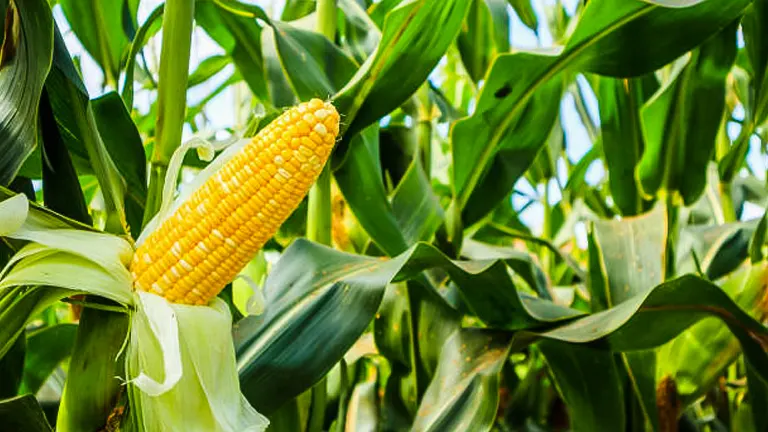
Sweet corn’s growth, yield, and quality are directly tied to its nutritional uptake, requiring a balanced diet of macronutrients and micronutrients from the soil. The primary macronutrients essential for sweet corn are Nitrogen (N), Phosphorus (P), and Potassium (K), each playing a unique role in plant development and health.
Nitrogen (N): Nitrogen is paramount for promoting vigorous leaf and stem growth in sweet corn. It’s a key component of chlorophyll, the molecule responsible for photosynthesis. Adequate nitrogen levels lead to lush, green growth and are pivotal for the early stages of plant development.
- Recommended Amount: 150-200 lbs/acre
- Deficiency Signs: Pale green or yellow leaves, starting with the older leaves as N is mobile and moves to new growth.
Phosphorus (P): Phosphorus plays a critical role in root development, flowering, seed development, and energy transfer within the plant. It’s essential for the transformation of solar energy into chemical energy, aiding in efficient photosynthesis and growth.
- Recommended Amount: 70-90 lbs/acre
- Deficiency Signs: Dark green leaves with a purplish tint, especially on the underside and along the veins. Delayed maturity and poor root development are common.
Potassium (K): Potassium is crucial for overall plant health, water regulation, enzyme activation, and disease resistance. It helps in the synthesis of proteins and starches, contributing to the size and quality of the kernels.
- Recommended Amount: 100-150 lbs/acre
- Deficiency Signs: Yellowing of leaf margins and tips, progressing inward with time. Weak stalks and reduced resistance to pests and diseases.
Micronutrients
Besides N, P, and K, sweet corn requires micronutrients like zinc (Zn), magnesium (Mg), and iron (Fe) in smaller quantities. Zinc is vital for enzyme systems and growth hormones, magnesium is a central component of chlorophyll, and iron is crucial for chlorophyll synthesis.
- Zinc (Zn) Recommended Amount: 0.5-1.0 lbs/acre
- Magnesium (Mg) Recommended Amount: 20-30 lbs/acre
- Iron (Fe) Recommended Amount: 2-4 lbs/acre
Nutritional Needs of Sweet Corn
| Nutrient | Role in Plant Health | Deficiency Symptoms |
|---|---|---|
| Nitrogen (N) | Supports leaf and stem growth, essential for chlorophyll and photosynthesis | Yellowing of older leaves, stunted growth |
| Phosphorus (P) | Aids in energy transfer, root development, and maturation | Delayed maturity, dark, dull, or purplish leaves |
| Potassium (K) | Regulates water, activates enzymes, improves disease resistance | Edge necrosis in leaves, weak stalks |
Additional Insights
Sweet corn requires approximately 1.2 pounds of nitrogen (N), 0.25 pounds of phosphorus (P₂O₅), and 0.2 pounds of potassium (K₂O) per 100 square feet for optimal growth. These values can vary based on soil type, weather conditions, and sweet corn variety. Implementing a soil testing regimen can provide precise nutrient-level information, allowing for targeted fertilization strategies.
Advanced Tips for Nutrient Management
- Soil Testing: Conduct soil tests every 2-3 years to monitor nutrient levels and adjust your fertilization strategy accordingly.
- Split Applications: For nitrogen, consider splitting the application, providing half at planting and the remainder when the plants are about knee-high to reduce leaching and ensure nutrients are available during peak demand.
- Foliar Feeding: Apply micronutrients through foliar sprays to quickly correct deficiencies, especially in critical growth stages.
Soil Preparation and Testing
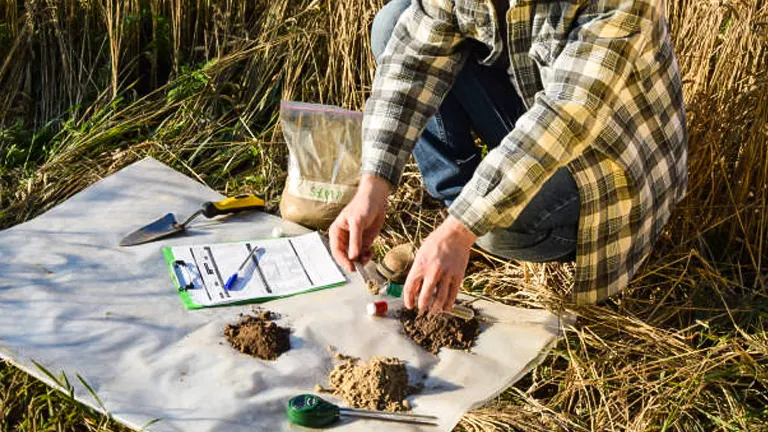
Optimizing soil health is the cornerstone of successful sweet corn cultivation. A comprehensive soil test is the first step in this process, offering invaluable insights into the soil’s current state and guiding amendments for optimal plant growth.
Key Parameters in Soil Testing
Soil tests evaluate several critical parameters, each influencing sweet corn’s growth differently:
- pH Level: Sweet corn thrives in slightly acidic to neutral soil. The ideal pH range is 6.0 to 6.8, ensuring nutrient availability and optimal microbial activity.
- Nutrient Profile: Essential nutrients, including Nitrogen (N), Phosphorus (P), Potassium (K), along with secondary nutrients and micronutrients, are quantified to pinpoint deficiencies.
- Organic Matter Content: Indicates soil fertility and its ability to retain moisture and nutrients.
- Cation Exchange Capacity (CEC): Reflects the soil’s ability to hold and exchange nutrients with plant roots, vital for nutrient management strategies.
Enhancing Soil Based on Test Results
Based on soil test findings, specific amendments can be made to tailor the soil environment to sweet corn’s needs:
- Adjusting pH: If the soil is too acidic, apply lime to raise the pH. If it’s too alkaline, sulfur can lower the pH to the desired range. The quantity depends on the initial pH and the soil type, with clay soils requiring more amendment than sandy ones due to their differing buffering capacities.
- Nutrient Amendments: Apply fertilizers based on the specific deficiencies identified. Use a balanced fertilizer for broad improvements or targeted amendments for specific nutrients. For example, bone meal can boost phosphorus, while greensand can increase potassium levels.
- Organic Matter Incorporation: Enriching the soil with compost not only improves its structure and water retention but also gradually increases nutrient levels and biological activity. Aim for a 4-6 inch layer of compost tilled into the top 8-12 inches of soil.
Scientific Analysis
| Parameter | Ideal Range for Sweet Corn | Amendment Strategy |
|---|---|---|
| pH | 6.0 – 6.8 | Lime to increase pH; Sulfur to decrease pH |
| Nitrogen (N) | 150-200 lbs/acre | Organic sources or synthetic N fertilizers |
| Phosphorus (P) | 70-90 lbs P₂O₅/acre | Bone meal, rock phosphate |
| Potassium (K) | 100-120 lbs K₂O/acre | Greensand, sulfate of potash |
| Organic Matter | 5-10% | Compost, aged manure |
Note: Application rates and strategies should be tailored based on specific soil test results and local conditions.
Choosing the Right Fertilizer
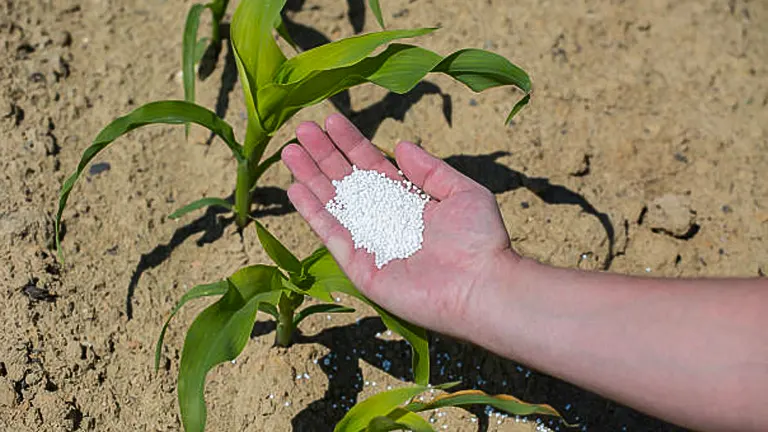
The foundation of a bountiful sweet corn harvest lies not just in selecting the right fertilizer but in understanding the nuances of how different fertilizers affect your crop and soil ecosystem.
Understanding Fertilizer Types
- Synthetic Fertilizers: These are chemically manufactured to provide quick nutrient availability to plants. They come in various formulations, each designed to release nutrients at different rates and ratios. Examples include urea (high in nitrogen), superphosphate (high in phosphorus), and muriate of potash (high in potassium).
- Organic Fertilizers: Derived from natural sources such as plants, animals, and minerals, organic fertilizers release nutrients more slowly, improving soil structure and microbial activity over time. Examples include bone meal (rich in phosphorus), blood meal (high in nitrogen), and wood ash (source of potassium).
Tailoring Fertilizer Choice to Soil Test Results
Nutrient-Specific Needs: If the soil test reveals a deficiency in a particular nutrient, select a fertilizer that specifically targets that need. For instance:
- For nitrogen deficiency, consider a fertilizer with a higher N ratio, such as ammonium nitrate (34-0-0) or fish emulsion for an organic option.
- Phosphorus-poor soils benefit from rock phosphate (0-3-0) or bone meal (3-15-0).
- Potash shortages can be addressed with sulfate of potash (0-0-50) or kelp meal for an organic source.
Balanced Fertilization: In the absence of specific deficiencies, a balanced N-P-K fertilizer supports general growth and maintenance. The ratio, such as 10-10-10, provides an equal part of each primary nutrient. Organic alternatives like compost provide a broad spectrum of nutrients along with beneficial microorganisms.
Advanced Considerations for Fertilizer Application
- Release Rates: Synthetic fertilizers often provide immediate nutrient availability, which is essential during critical growth phases. However, their overuse can lead to nutrient runoff and soil degradation. Organic fertilizers, by contrast, release nutrients slowly, building long-term soil fertility.
- Environmental Impact: Organic fertilizers contribute to the sustainability of gardening practices by reducing chemical runoff and enhancing soil biodiversity.
- Application Strategies: Apply fertilizers according to the growth stage of the sweet corn. Initial applications should focus on nitrogen to support early growth, followed by balanced fertilization as the plants mature to support overall health and productivity.
Step-by-Step Guides on How to Fertilize Sweet Corn
Step 1: Soil Testing
- Collect Soil Samples: Before planting, collect soil samples from several locations in your garden to get an accurate representation of your soil’s health.
- Get a Soil Test: Send the samples to a local extension service or a soil testing lab. Request a detailed analysis including pH, N-P-K (Nitrogen, Phosphorus, Potassium) levels, and recommendations for amendments.
- Interpret the Results: Review the soil test report to understand what your soil lacks or has in excess.
Step 2: Choosing the Right Fertilizer
- Select Based on Soil Needs: Choose a fertilizer that matches the specific needs identified in your soil test. For general needs, a balanced N-P-K fertilizer is a good start.
- Synthetic vs. Organic: Decide between synthetic fertilizers for quick nutrient release or organic fertilizers for slower, more sustainable nutrient release and soil health improvement.
Step 3: Preparing the Soil
- Amend the Soil: Based on your soil test, add lime to raise pH or sulfur to lower pH if needed. Mix in the recommended amount of fertilizer or organic matter to enrich the soil.
- Till the Soil: Till the soil to a depth of 6-8 inches to incorporate the amendments thoroughly and prepare for planting.
Step 4: Initial Fertilization
- Apply Starter Fertilizer: At planting, use a starter fertilizer high in phosphorus to promote root development. Apply according to package instructions or your soil test recommendations.
- Side-Dressing: When your sweet corn is about 4-6 inches tall, apply a side dressing of nitrogen-rich fertilizer to support rapid growth.
Step 5: Monitoring and Maintenance
- Watering: After fertilizing, water your corn plot thoroughly to help dissolve the fertilizer and encourage deep root growth.
- Observation: Monitor your plants for signs of nutrient deficiency or excess and adjust your fertilization plan accordingly.
Step 6: Additional Fertilization
- Second Side-Dressing: Apply another side dressing of nitrogen when the corn is about knee-high, usually 3-4 weeks after the first application, to support continued growth and ear development.
Step 7: Pre-Harvest Boost
- Final Fertilization: Depending on your soil test and observed plant health, a final light application of a balanced fertilizer may be beneficial as the corn begins to tassel to support ear development and filling.
Step 8: Post-Harvest Care
- Soil Recovery: After harvest, consider planting a cover crop to help fix nitrogen in the soil and improve soil structure for the next planting season.
Additional Tips
- Always follow the manufacturer’s instructions when using synthetic fertilizers to avoid over-fertilization and potential plant damage.
- Consider using drip irrigation or soaker hoses to reduce water waste and prevent diseases associated with wet foliage.
- Keep records of your fertilization schedule, amounts, and plant responses to refine your strategy over time.
Plant Spacing for Optimal Growth

Achieving the perfect balance in sweet corn cultivation involves not just planting seeds but understanding the spatial dynamics that support healthy growth and maximize yield. Here’s a deeper look into optimizing plant spacing for sweet corn:
The Science of Spacing
- Row Spacing: The recommended 30 to 36 inches between rows is designed to accommodate the growth habits of sweet corn and the equipment used in garden or field settings. This spacing helps in efficient nutrient uptake and allows for better pest and weed management.
- Plant-to-Plant Spacing: Spacing plants 8 to 12 inches apart within rows is crucial for minimizing competition for sunlight, water, and nutrients. This distance balances the need for dense planting to maximize yield per acre with the need for each plant to access sufficient resources.
Impact on Growth and Yield
- Sunlight Penetration: Proper spacing ensures that each sweet corn plant receives adequate sunlight, essential for photosynthesis and the development of healthy ears.
- Air Circulation: Increased air flow around plants reduces the humidity in the leaf canopy, significantly lowering the risk of fungal diseases such as rust and blight.
- Nutrient Access: Adequate spacing minimizes root competition for nutrients, allowing each plant to absorb the necessary elements for vigorous growth and kernel development.
Unique Insights and Considerations
- Density vs. Quality: Research shows that while closer spacing can increase the number of ears per acre, it may also reduce the size and quality of each ear. Finding the right balance is key to achieving both high yield and quality.
- Soil Fertility: Highly fertile soils can support closer spacing by sustaining more plants per unit area without significant yield loss. In contrast, less fertile soils may require wider spacing to maintain plant health and productivity.
- Microclimate Management: Proper spacing contributes to creating a favorable microclimate within the cornfield, reducing moisture retention on leaves and stems, and thus lowering disease pressure.
Tailoring Spacing to Varietal Needs
Different sweet corn varieties may have specific spacing requirements based on their growth habits and size. Smaller, more compact varieties can be planted slightly closer together, while larger, more vigorous varieties may benefit from wider spacing to reach their full potential.
Practical Application and Adjustments
- High-Density Planting: In high-density scenarios, consider slightly reducing the distance between plants but monitor closely for signs of stress or competition.
- Row Orientation: Align rows north to south for maximum sunlight exposure across the day, optimizing photosynthetic efficiency and growth.
Pruning Techniques for Sweet Corn
While sweet corn does not require extensive pruning like other crops, removing suckers (the shoots that appear at the base of the plants) can help redirect the plant’s energy towards growing taller and producing more ears. However, it’s important to approach pruning with caution, as excessive removal of growth can stress the plants. Only remove suckers that are significantly draining resources from the main stalk, and always leave the primary shoots and leaves intact to ensure the plant can photosynthesize effectively.
Timing and Application of Fertilizer

Successful sweet corn cultivation hinges on understanding and responding to the plant’s nutritional needs throughout its growth cycle. Here’s how to navigate the fertilization process with precision and care.
Initial Fertilization
- Pre-Planting Considerations: Incorporate a balanced, slow-release fertilizer into the soil 1-2 weeks before planting. Look for formulas with an N-P-K ratio that matches your soil test recommendations, typically around 10-10-10 or similar.
- At Planting: Apply a starter fertilizer that is slightly higher in phosphorus to encourage root development. Position the fertilizer about 2 inches to the side and 2 inches below the seed depth to avoid direct contact with seeds, which could lead to damage.
Nutritional Phases and Corresponding Fertilization
- Vegetative Growth Phase:
- As the corn emerges and begins its vegetative growth, its nitrogen needs increase. Approximately 3-4 weeks after planting, when the plants are about knee-high, apply a side dressing of nitrogen-rich fertilizer to support this rapid growth.
- Application Tip: Use a nitrogen source like urea or an ammonium nitrate blend, applying it in a band at least 6 inches away from the base of the plants to prevent root burn.
- Pre-Tasseling to Tasseling Phase:
- This is a critical phase where the corn prepares to pollinate. A second side dressing may be beneficial, especially if the initial growth has been vigorous and the green color of the plants is starting to pale, indicating nitrogen depletion.
- Consideration: Evaluate the plants’ color and vigor before applying additional nitrogen, as excessive growth can sometimes hinder optimal ear development.
Application Techniques for Maximum Efficiency
- Even Distribution: When applying granular fertilizers, ensure an even distribution around the plant’s base, avoiding direct contact with the foliage or stalks. Utilize a spreader for larger areas to achieve uniform coverage.
- Incorporation: Lightly till the fertilizer into the top inch of soil or water it in thoroughly to ensure that the nutrients reach the root zone where they are most needed.
- Watering In: After applying fertilizer, irrigate the area to help dissolve and carry the nutrients into the soil profile. This step is crucial for making the nutrients readily available to the plant’s roots and for preventing nutrient loss through volatilization or runoff.
- Utilizing Slow-Release Formulas: For gardeners seeking to minimize labor or for those in regions with unpredictable rainfall, slow-release or controlled-release fertilizers offer an efficient way to provide sustained nutrition without the need for frequent applications.
Advanced Insights for Precision Fertilization
- Soil Moisture Monitoring: Maintain consistent soil moisture levels, especially after fertilizing, to facilitate nutrient uptake. Avoid over-watering, which can leach nutrients past the root zone, and under-watering, which can stress the plants and reduce their ability to utilize available nutrients.
- Foliar Feeding: Consider supplemental foliar applications of micronutrients (such as zinc or boron) if soil tests indicate deficiencies. These should be applied according to product instructions, typically during cooler parts of the day to avoid leaf burn.
Watering and Fertilizer Management
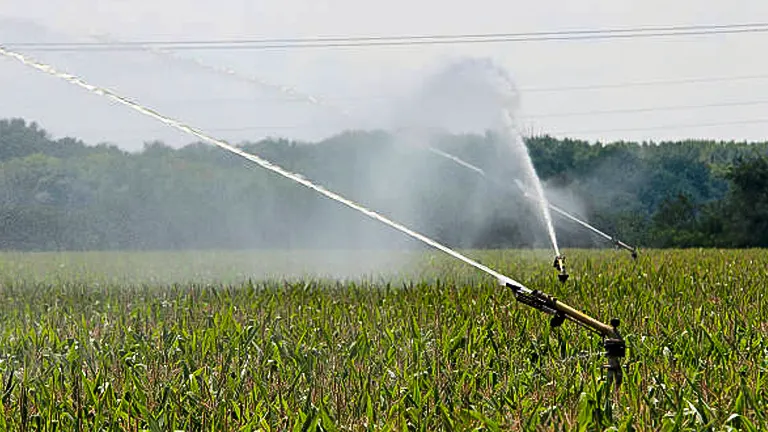
Optimal growth and productivity of sweet corn are heavily dependent on the strategic management of watering and fertilization. Understanding the interplay between these two elements can significantly impact the efficiency of nutrient uptake and overall plant health.
When it comes to fertilizer management in relation to watering, it’s essential to ensure that the soil is moist when applying fertilizer. This practice helps prevent fertilizer burn and ensures nutrients are more readily available to the plant’s roots. Additionally, consider the type of fertilizer being used; water-soluble fertilizers may require more frequent applications compared to slow-release types, which can reduce the labor and attention needed over the growing season.
Monitoring Growth and Adjusting Care

Regularly monitoring your sweet corn’s growth allows you to adjust care as needed. Pay attention to the color of the leaves, the strength of the stalks, and the development of the ears. If you notice signs of nutrient deficiency or excess water stress, it may be time to adjust your fertilization or watering schedule. For instance, yellowing leaves can indicate a nitrogen deficiency, necessitating a side dressing of a nitrogen-rich fertilizer.
Precision Watering Techniques
- Soil Moisture Monitoring: Utilize moisture meters or the feel method to monitor soil moisture levels. Sweet corn thrives in soil that remains consistently moist but not waterlogged. The goal is to maintain a balance that supports active root absorption without leaching essential nutrients.
- Drip Irrigation: Implementing drip irrigation systems can dramatically improve water use efficiency. By delivering water directly to the base of each plant, drip systems reduce evaporation losses and minimize the risk of foliar diseases associated with overhead watering.
- Mulching: Apply organic mulch around the base of sweet corn plants. Mulch helps retain soil moisture, reduces soil temperature fluctuations, and minimizes weed competition. As a bonus, organic mulches gradually break down, contributing to soil fertility.
Integrating Watering with Fertilizer Application
- Moisture Before Fertilizing: Ensure the soil is adequately moist before applying granular or liquid fertilizers. Dry soil can inhibit the dissolution and distribution of nutrients, while overly wet conditions can lead to nutrient runoff or leaching.
- Watering After Fertilizing: Following fertilizer application, water the area lightly to help move the nutrients into the root zone. This step is particularly crucial for water-soluble and granular fertilizers to prevent nutrient loss and to facilitate immediate uptake.
- Fertilizer Types and Watering Regimes:
- Water-Soluble Fertilizers: Offer immediate nutrient availability and are ideal for quick boosts during critical growth phases. However, they may require more frequent application and careful irrigation to prevent leaching.
- Slow-Release Fertilizers: These formulations release nutrients gradually over time, matching the plant’s nutrient uptake more closely and reducing the need for frequent applications. They are particularly effective when used in conjunction with consistent moisture levels maintained by drip irrigation or careful watering practices.
Nutrient Management in Variable Weather Conditions
- Adjusting to Rainfall: In periods of heavy rainfall, monitor nutrient levels closely, as excessive water can leach nutrients from the soil. Supplement with additional fertilizer if necessary, based on soil tests or visible signs of nutrient deficiency.
- Drought Strategies: During drought conditions, prioritize deep, infrequent watering to encourage root systems to extend deeper into the soil, where moisture levels are more stable. Adjust fertilizer applications to match the reduced water availability, focusing on maintaining a balance that supports plant health without overloading with nutrients that cannot be effectively utilized.
Fertilization Schedules
- Lifecycle-Based Fertilization: Adjust fertilizer types and application rates according to sweet corn’s growth stages. Early stages may benefit from higher nitrogen levels to support leaf and stem development, while phosphorus and potassium become more critical as the plant transitions to flowering and ear development.
Tips for Harvesting and Storing Sweet Corn
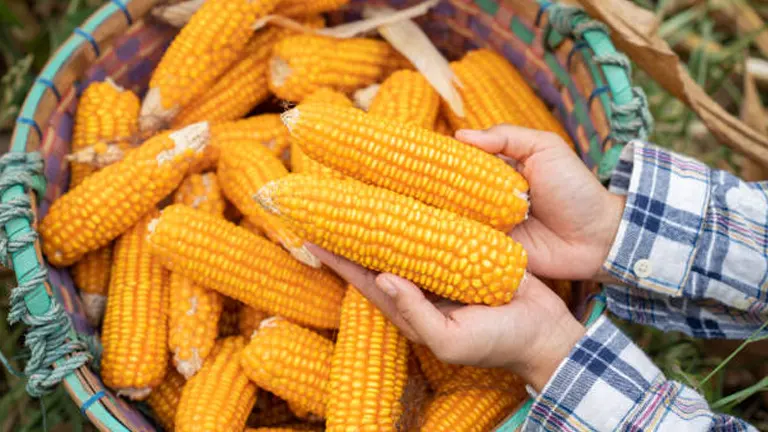
To enjoy the fruits of your labor:
- Harvest Timing: Sweet corn is best harvested when the kernels are full and milky; this is typically 18-20 days after the first silk strands appear. The silk should be brown, but the husks green.
- Harvesting Method: Twist the ear downward from the stalk; this prevents damage to the plant.
- Storage: Sweet corn loses its sweetness quickly after harvesting. For best flavor, consume it the same day it’s picked or store it in the refrigerator with husks on for up to a week. For longer storage, blanch the ears and freeze them.
Common Pest Management for Each Season
Spring
Common Pest: Cutworms
- Cutworms are caterpillars that cut down young plants at the soil surface during the night.
- Solution: Place collars (e.g., toilet paper rolls or plastic cups with bottoms removed) around seedlings to protect them. Keeping the garden clean of weeds and debris can also deter them. For severe infestations, consider using Bacillus thuringiensis (Bt) or other appropriate insecticides as directed.
Early Summer
Common Pest: Corn Borer
- Corn borers bore into stalks, weakening and sometimes killing the plant. They can also get into the ears, ruining the kernels.
- Solution: Planting corn borer-resistant varieties is a key preventive measure. Releasing beneficial insects like Trichogramma wasps, which parasitize corn borer eggs, can help manage populations. Applying Bt before the larvae enter the plant can also be effective.
Mid to Late Summer
Common Pest: Corn Earworm
- Corn earworms feed on the tips of corn ears, damaging kernels and opening the door to disease.
- Solution: Apply mineral oil to the silk 5-7 days after silk emergence to deter egg-laying. Planting early can help avoid peak infestations. For organic control, Bt or spinosad can be effective when applied directly to the ear tips as the silks begin to brown.
Common Pest: Aphids
- Aphids suck sap from plants, causing leaves to curl and weaken; they also excrete a sticky substance called honeydew, which can lead to sooty mold.
- Solution: Encourage or introduce natural predators like ladybugs and lacewings. For severe infestations, use insecticidal soaps or neem oil applied directly to the aphids. Ensure plants are well-watered and healthy to withstand and recover from attacks.
Throughout the Growing Season
Common Pest: Rootworms
- Rootworm larvae feed on corn roots, causing plants to become unstable and potentially fall over.
- Solution: Crop rotation is one of the most effective strategies against rootworms, as they typically lay eggs in cornfields and the larvae need corn roots to survive. For non-rotatable gardens, consider using a soil insecticide or planting rootworm-resistant varieties.
Common Mistakes and Solutions
Navigating Challenges in Sweet Corn Cultivation
- Overcrowding: Address the consequences of planting sweet corn too closely and how to avoid this mistake.
- Improper Watering: Discuss the pitfalls of both overwatering and underwatering, providing guidelines for proper irrigation practices.
- Fertilization Errors: Highlight common fertilization mistakes, such as overuse of nitrogen or improper timing, and how to correct them.
- Neglecting Pest and Disease Management: Stress the importance of regular monitoring for pests and diseases and implementing management strategies promptly.
Conclusion
In summary, effective fertilization is crucial for sweet corn’s growth and productivity. By carefully selecting the right fertilizers, timing your applications, and monitoring plant health, you can significantly enhance your sweet corn’s performance. Keep it simple, stay observant, and enjoy the lush, bountiful harvest your efforts will bring.
FAQs
- How does the spacing of sweet corn affect its fertilization needs?
Closer spacing can increase competition for nutrients, requiring more precise fertilization to ensure each plant receives adequate nourishment. Conversely, wider spacing may reduce nutrient competition but could necessitate broader application to cover the increased area. - Can the type of sweet corn variety influence its fertilizer requirements?
Yes, different varieties may have varying nutrient needs. For instance, super sweet varieties often require more nitrogen than standard types due to their higher sugar content and rapid growth rates. - How does the time of day affect the efficiency of fertilizing sweet corn?
Applying fertilizers in the early morning or late afternoon can reduce the risk of nutrient evaporation and ensure more nutrients reach the soil, making the process more efficient, especially in hot climates. - Is there a way to fertilize sweet corn to enhance its sweetness?
While sweetness is largely genetic, ensuring optimal levels of potassium can improve overall plant health and potentially enhance the natural sweetness of the corn by supporting sugar translocation to the kernels. - How do cover crops interplay with fertilizing strategies for sweet corn?
Planting leguminous cover crops before sweet corn can naturally enrich the soil with nitrogen, potentially reducing the need for synthetic fertilizers and promoting a more sustainable fertilization strategy. - What role does pH play in fertilizing sweet corn, and how can it be managed?
Soil pH affects nutrient availability; sweet corn prefers a slightly acidic to neutral pH (6.0-7.0). If soil tests reveal pH imbalances, adjusting it with lime (for acidic soils) or sulfur (for alkaline soils) before fertilizing can help maximize nutrient uptake. - Can the use of mycorrhizal fungi inoculants improve fertilization outcomes for sweet corn?
Yes, mycorrhizal fungi form symbiotic relationships with sweet corn roots, enhancing water and nutrient absorption, particularly phosphorus. Applying inoculants at planting can improve fertilization efficiency and plant resilience. - How can I use foliar feeding in conjunction with soil fertilization for sweet corn?
Foliar feeding can provide quick nutrient boosts during critical growth stages, such as just before tasseling. It’s best used as a supplement to soil fertilization, targeting specific deficiencies identified through leaf tissue analysis for precise nutrient delivery.
With these insights and strategies, you’re ready to give your sweet corn the best start and support it needs for optimal growth. Embrace the journey and look forward to the delicious outcome of your efforts. Happy growing!

Benjamin Brooks
Forestry AuthorGreetings! I'm Benjamin Brooks, and my journey over the past 15 years has revolved around the fascinating realms of content creation, expertise in snow clearing, and the intricate world of lumberjacking and landscaping. What began as a simple curiosity about the natural world and heavy machinery has evolved into a passionate profession where my love for crafting words intertwines seamlessly with my lumberjacking and garden skills.












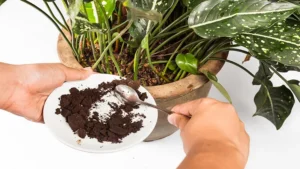
Leave your comment